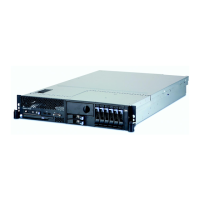Declared Acoustical Noise Emissions
Eserver pSeries 655Product
Configuration
Declared A-Weighted Sound Power
Level, L
WAd
(B)
Declared A-Weighted Sound Pressure
Level, LpAm (dB)
Operating Idle Operating Idle
One processor node (16 max.),
nominal conditions,
non-acoustical doors
7.4 7.4 57 57
One processor node (16 max.)
nominal conditions, acoustical
doors
6.7
(4)
6.7
(4)
50
(4)
50
(4)
Typical configuration of (3
processor nodes, bulk power, 1
I/O drawer), nominal conditions,
non-acoustical doors
8.2 8.2 64 64
Typical configuration of (3
processor nodes, bulk power, 1
I/O drawer), nominal conditions,
acoustical doors
7.5
(4)
7.5
(4)
57
(4)
57
(4)
Maximum configuration of (16
processor nodes, bulk power),
nominal conditions,
non-acoustical doors
8.7
(3)
,
(4)
8.7
(3)
,
(4)
69
(3)
,
(4)
69
(3)
,
(4)
Maximum configuration of (16
processor nodes, bulk power),
nominal conditions, acoustical
doors
8.0
(3)
,
(4)
8.0
(3)
,
(4)
62
(3)
,
(4)
62
(3)
,
(4)
Notes:
1. L
WAd
is the upper-limit A-weighted sound level; LpAm is the mean A-weighted sound pressure level measured at
the 1-meter bystander positions; 1 B = 10 dB.
2. All measurements made in conformance with ISO 7779 and declared in conformance with ISO 9296.
3. Attention: Your server installation may be subject to government regulations (such as those prescribed by
OSHA or European Community Directives) that cover noise-level exposure in the workplace. The Eserver
pSeries 7040-W42 rack is available with an optional-acoustical-door feature. This feature can reduce the
likelihood of exceeding the noise-level-exposure limits for racks that are ″densly populated″ with Eserver
pSeries 7039-651 processor nodes. The actual sound-pressure levels in your installation will depend on a variety
of factors, including the number of racks that are installed; the size, materials, and configuration of the room
where the racks are installed; the noise levels from other equipment; the room ambient temperature; and
employees’ location in relation to the equipment. It is recommended that a qualified person, such as an industrial
hygienist, be consulted to determine if the sound-pressure levels that employees may be exposed to exceed
regulatory limits.
4. These numbers are based on preliminary data and are subject to change.
Environmental Specifications
Environmental Specification Operating Non-Operating Storage Shipping
Temperature 10 to 32°C
(50 to 90°F)
10 to 43°C
(50 to 109°F)
1 to 60°C
(34 to 140°F)
–40 to 60°C
(–40 to 140°F)
Relative Humidity
(Noncondensing)
8 to 80 % 8 to 80 % 5 to 80 % 5 to 100 %
Maximum Wet Bulb 23°C (73°F) 27°C (73°F) 29°C (84°F) 29°C (84°F)
Chapter 2. Physical Characteristics of Systems 97
